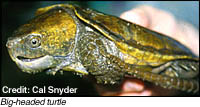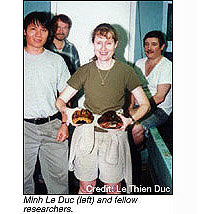
| Fall 2000 |
Turtles
in Trouble
Viet Nam's Wildlife
Is Being Traded Away
Click on any image below for more detailed
caption info!
|
The best place to find wild turtles in Viet Nam may be at a market stall in China. |
Minh Le Duc, a Vietnamese student in the international graduate student program sponsored by the CBC, is writing his dissertation on the trade in wild turtles in Viet Nam. In his home country he might be able to do most of his field work in the marketplace. In fact, he might have better luck finding turtles in the market than in the wild. And the best place to find Vietnamese turtles—and Laotian, Cambodian, Thai and Malaysian turtles—may be in China.

In 1989 Viet Nam opened its borders to trade with China. Since then, according to Minh, many resources have gone over that border, including vast quantities of the country's wildlife.
With its enormous population and rapidly developing economy, China is a big market for wildlife. Wild animals are used both for food and for traditional medicine, and while such use of wildlife is of long standing, what is new is the opening of trade with the countries of Southeast Asia, coupled with the probable exhaustion of some target species in China itself. The Chinese market is draining species from the surrounding countries. According to an article in the New York Turtle and Tortoise Society newsletter (No. 1, January 2000) by Sandra Altherr and Daniela Freyer, as many as 12 million turtles may be sold in China every year.
When trade with China opened up, a boom in collecting wildlife developed in Viet Nam, Minh says. People found they could get high prices for certain animals--as much as $1000 for one species of turtle (Cuora trifasciata, the three-striped box turtle, believed in China to cure cancer).
Turtles are not the only animals affected. Snakes, frogs, and many species of birds and mammals are carried to China, legally and illegally. Many of these come from, or pass through, Viet Nam.
Previously, Viet Nam had a domestic trade in deer and other wild animals—including turtles—for food and medicine, and as pets. Wildlife still commonly shows up on local restaurant menus. But the effects of this trade were nothing like the scale of trade with China, says Minh. The trade has spread even to remote areas, where local people collect wildlife, then sell it to brokers, who in turn sell the animals to the China trade.
The wildlife trade is having a noticeable impact on the country's biodiversity. "You hear all kinds of stories," says Minh.
"Basically, the whole ecosystem collapsed," he says.
The trade in turtles is not unique to Viet Nam, of course. Southeast Asia is now the hotspot for commercial turtle collecting, both for the pet trade and for sale to China as food and medicine. Many turtles collected in Laos and Cambodia are believed to pass through Viet Nam on their way to China.
There are already laws in place to limit this trade, and many shipments are confiscated at the Vietnamese border. But because the trade is so widespread, the demand so great, and the people living around forests and national parks who collect the turtles are often very poor, it is difficult to halt.
In 1996-97 Fauna and Flora International and Cuc Phuong National Park began the Turtle Conservation and Ecology Project (TCEP), founded in response to the threats to Viet Nam's turtle population. Part of this project involved setting up a rescue center for turtles near the ranger station on the main north-south highway in Viet Nam, where many turtles are confiscated. Previously the rangers had been releasing confiscated turtles almost immediately, since they had no facilities for keeping them. Not only did this mean often releasing turtles into habitat and climate to which they might not be adapted, but the released turtles were rapidly collected by local people.

According to their newsletter, the TCEP maintains nearly 200 turtles, representing 18 of Viet Nam's 22 species. The program also breeds turtles, raising the hatchlings. They have already released confiscated turtles in some areas of Viet Nam; more releases will be made in the near future, when the wildlife trade is brought under better control
Scientists from the Institute of Ecology and Biological Resources (IEBR) in Hanoi, have joined with scientists from other countries signatory to the Convention on International Trade in Endangered Species of Wild Fauna and Flora (CITES) to recommend that all turtles be listed in Appendix II of CITES. By listing all turtles in Appendix II, permits would be required for any turtle trading, and problems with identifying particular species as protected or not would be moot. (In April 2000, all Asian box turtles (Cuora spp.) were added to Appendix II of CITES.)
Minh plans to help set up a conservation program for turtles and other endangered species when he returns to Viet Nam after he receives his master's degree. His work will be cut out for him, he says: "Viet Nam has a lot of work to do in the next few years to protect its wildlife resources."
— Marc Lecard
| Resources | ||
Convention on International Trade in Endangered Species of Wild Fauna and Flora
www.cites.org
TRAFFIC Documents: Investigations into Tortoise and Freshwater Turtle Trade in Viet Nam. Le Dien Duc and Steven Broad. A report by the NWF/IUCN/WWF Programme for Endangered Species in Asia, in collaboration with TRAFFIC southeast Asia. 1995.
An Overview of the Wildlife Trade In Five Southeast Asian Countries. A report prepared for the IUCN Sustainable Use of Wildlife Programme. June 1994.
CONTACT:
TRAFFIC
Southeast Asia—Regional Office Locked Bag No. 911, Jln Sultan PO
46990 Petaling Jaya, Selangor, Malaysia
Telephone: (60) 3 7944097
Fax: (60) 3 7947220
email: tsea@po.jaring.my
The Turtle Conservation
and Ecology Project c/o The Cuc Phuong Conservation Project Cuc Phuong
National Park, Ninh Binh Province, Viet Nam
email: cpcp@fpt.vn
website: http://nytts.org/vietnam/
Telephone:
030848-004
New York Turtle
and Tortoise Society P.O. Box 878 Orange, NJ 07051-0878
Website: http://nytts.org/
Links to:
The Asian Turtle Crisis:
http://nytts.org/asianturtlecrisis.html
The Cuc Phuong Project:
http://nytts.org/vietnam/
World Wide Fund for Nature (WWF): www.panda.org
World Wildlife Fund UK: www.wwf-uk.org/eyes/trade.htm
TortoiseAid International www.tortoiseaid.org/asianturtles.html
|
|
| Also in this edition >>> |
Turtles in Trouble >>
The Conservation Education Network >> Viet Nam: Filling in the Gaps >> Of Gastropods and Bivalves >> Interpreting Biodiversity in Viet Nam >> The Beauty of Leeches >> Leech Prospecting in the Bolivian Andes >> |
| Next Article >> |
Biodiversity Center Home | Center Programs | Publications | News & Events | Features| Museum Home
